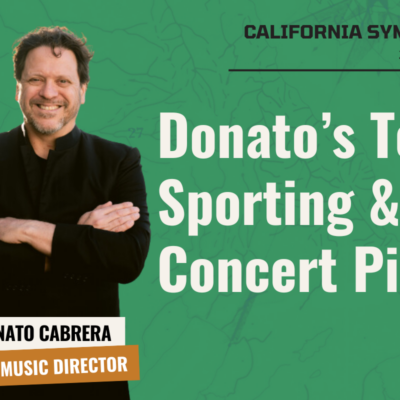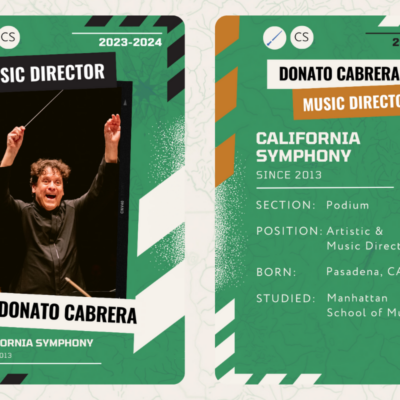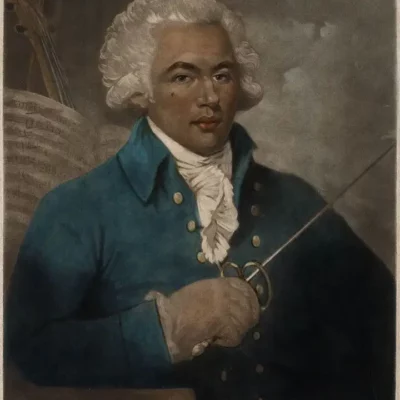
Music Director Donato Cabrera reflects on Mahler, whose Symphony №4 is featured in our season opener, LYRICAL DREAMS, on Sunday, September 24.
When listening to a composition by Gustav Mahler, try to think about time and place. As in, the precise time and place Mahler aimed to convey in the music.
Mahler was trying to create an entire environment, whether it’s going back to his childhood in Bohemia or dealing with the knowledge of his own mortality. His music is an entire universe. It’s a philosophy, it’s geography, it’s smelling the blossoms in the air. Through his music, he’s really trying to touch all the senses.
The Austrian composer, born 1860, applied unique methods to his music. These included infusing his compositions with the melodies of street musicians and sounds depicting everyday noises, all with the aim of creating a snapshot of life. It had really never been explored to this degree by other composers, and it’s for this very reason that his music wasn’t popular in Vienna during his lifetime.
Mahler’s Symphony №4 is a prime example of the composer’s style. The symphony, written as an exploration of the world through a child’s eyes, includes sounds borrowed from Mahler’s own rural childhood, such as sleigh bells that were commonly strung on horses. The symphony’s second movement goes a step further, with a solo violin recreating a common fairy tale of the time, in which a sinister pied piper lures children out of a village.
It’s a direct reference to what was a very real concern for children, noting the many dangers for children in an era when outdoor lighting at night was uncommon. This was the typical message: Don’t talk to strangers. Bad things will happen if you follow a stranger out of the village.
Another strong theme can be observed in many of Mahler’s compositions: death. This includes his “Kindertotenlieder” (“Songs on the Death of Children”), comprised of songs based on poems about the grieving process. Some even link elements of his symphonies to deaths and illness experienced in his own family. This merely reflects the era Mahler lived in when the average lifespan was short and most families expected to lose multiple children to illness. It’s sort of like the Blues. It’s only through accepting hardship and looking it straight in the face that one finds solace and beauty in it.
Mahler’s music has had tremendous influence with composers throughout the 20th century emulating his musical style and focus. Mahler’s style can still be seen in European music composed today. The prevalence of his music stems back to the relatability of his compositions, which held greater appeal to audiences as society opened up to understanding human emotion and experience at the turn of the century.
Why it’s become so popular and why it captures the hearts of so many people is really that it’s a great reflection of the 20th century and who we are as modern individuals. That’s why his music became so ubiquitous.
Originally published on the Smith Center’s Blog http://www.thesmithcenter.com/blog/listening-to-mahler-more-than-just-music/
LYRICAL DREAMS is at the Lesher Center in Walnut Creek on Sunday September 24 at 4pm and includes:
Barber’s Knoxville: Summer of 1915
Stookey YTTE (Yield To Total Elation)
Mahler Symphony №4
Tickets are available at 925.943.SHOW and LesherCenter.com. Prices start at just $33 per concert.
ABOUT CALIFORNIA SYMPHONY
The California Symphony, now in its fifth season under the leadership of Music Director Donato Cabrera, is a world-class, professional orchestra based in Walnut Creek, in the heart of the San Francisco East Bay since 1990. Our vibrant concert series is renowned for featuring classics alongside American repertoire and works by living composers. The Orchestra is comprised of musicians who have performed with the orchestras of the San Francisco Symphony, San Francisco Opera, San Francisco Ballet, and others, and many of its musicians have been performing with the California Symphony for nearly all its existence.
Outside of the concert hall, the symphony actively supports music education for social change through its El Sistema-inspired Sound Minds program at Downer Elementary School in San Pablo, CA. The initiative brings intensive music instruction and academic enrichment to Contra Costa County schoolchildren for free, in an area where 94% of students qualify for the federal free or reduced price lunch program.
We also host the highly competitive Young American Composer-in-Residence program, which this year welcomes its first female composer, Katherine Balch.
California Symphony has launched the careers of some of today’s most-performed soloists and composers, including violinists Sarah Chang and Anne Akiko Meyers, cellist Alisa Weilerstein, and composers such as Mason Bates, Christopher Theofanidis, and Kevin Puts. The Orchestra performs at the Lesher Center for the Arts in Walnut Creek.
For more information, please visit californiasymphony.org.



